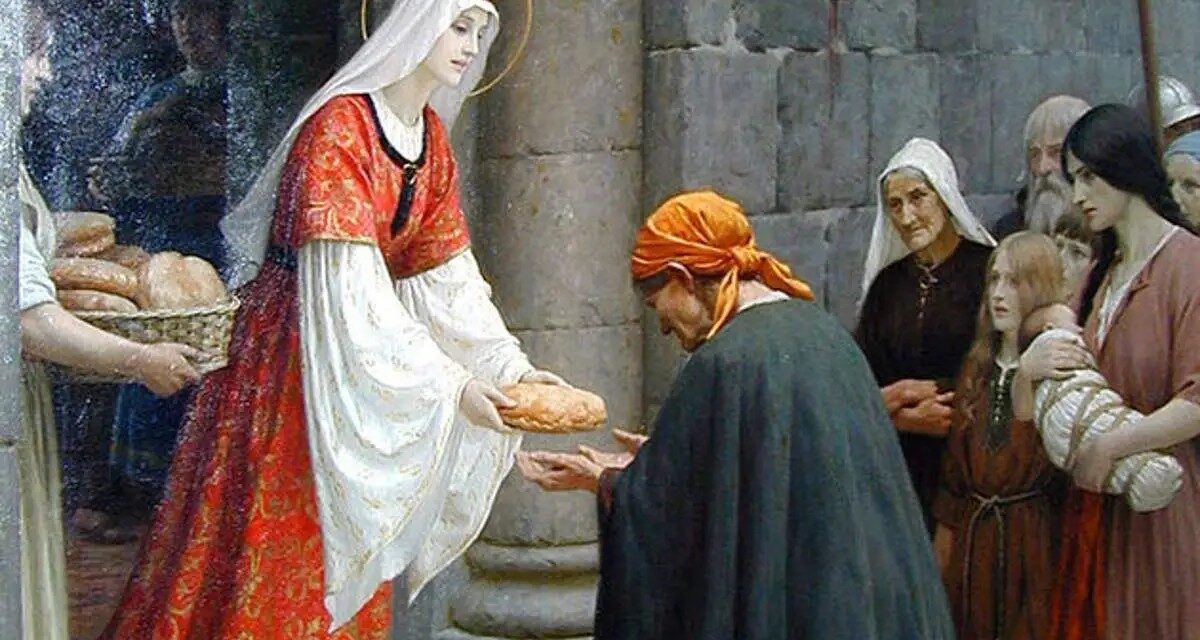793 years ago, on November 17, 1231, Saint Elizabeth of Árpád-háza (Saint Elizabeth of Thuringia), the patroness of the poor and children, died. Her life, starting with her husband's death in 1227, was a series of persecutions and humiliations.
II was born in 1207. As the third child of King András and Gertrud of Meránia, tradition also counts Bratislava, Sárospatak and Óbuda as his birthplace. Among his many brothers, the best known is IV. Béla was one of the defining figures of Hungarian history. When she was four years old, she was betrothed to the eldest son of Thuringian Viscount Hermann I and took her to Thuringia. He grew up in Eisenach and then in the Wartburg (a castle that still stands today) under the personal supervision of the religious, literature- and music-loving Margrave. His mother was murdered in Hungary in 1213, the news shocked him greatly and he was haunted by nightmares for a long time.
Her trials were compounded by the fact that her fiance, who had been ill a lot, died three years later. Elizabeth - although her piety was sometimes felt to be excessive - was liked by everyone. The only exception was her future mother-in-law, who took it for granted that she refused to learn the waddle walk that was compulsory for women, and her favorite pastime was horse riding. After some political tug-of-war, the deceased groom's younger brother, Lajos, got engaged to her - by the way, he was Erzsébet's favorite childhood playmate.
The wedding took place in 1221, and three children were born from the happy marriage in a few years: Hermann, Zsófia and Gertrúd. The young wife in love broke all court customs, just so she could sit next to her husband at court feasts and not have to be separated from him even for a minute. She accompanied her beloved husband everywhere, be it hunting or betting.
From a very young age, he led a penitent lifestyle, often fasted, scourged himself, and wore a penance belt. After the birth of her first child, her vigils and fasts became more and more frequent, she opened a shelter for children and devoted more and more attention to the poor. Out of gratitude for the successful birth of her second child, she founded a hospital, where she took part in patient care herself, with which she did not achieve undivided success.
When Louis went to war in 1225, he entrusted the administration of the province to his wife. When a famine broke out, Elizabeth distributed a significant amount of food from the Wartburg's stocks, which her family members considered wasteful, but Lajos approved her decisions when he returned home. In 1227, Lajos had to join the Crusades as a vassal of II. On the side of Emperor Frederick. She tried in vain to get Elizabeth to change her decision, and finally she sewed the cross on her husband's clothes herself. From then on, she only wore mourning clothes, as if she had guessed the future: Lajos died on the way, and she never got to see her third child, born two days after her departure. Erzsébet did not recover from crying for eight days.
From then on, his life was a series of persecutions and humiliations. The twenty-year-old widow refused to give up her son's princely rights in favor of her brother-in-law, so Lajos' brothers deprived her of everything. The woman, who longed for poverty anyway, secretly left Wartburg, earned her living by spinning, and raised her children by selling her jewelry. Finally, Bishop Eckbert of Bamberg accepted the widow, whose hand in marriage was asked by King II. Frigyes got a basket. Erzsébet soon settled in Marburg, where she set up a hospital from her widow's possessions. He naturalized the Third Order of St. Francis of Assisi in Germany, and even changed his everyday dress to a gray robe. Vomited fate and II. Despite András's call, he did not return to Hungary.
1231. Pope Gregory appointed Konrad of Marburg as his confessor and protector. According to the instructions of the strict ascetic Franciscan priest, he tried to create an order of nuns who lived according to monastic rules but did not take vows, practicing charity and caring for the sick. He fell ill in November 1231, and named the day of his death three days earlier. He spent his last days serenely, distributing everything he had and comforting those who were watching by his side. He died on 17 November 1231 in Marburg.
Many wonderful events took place at his grave, so it is no wonder that IX. Pope Gregory canonized him already in 1235. His holiday was added to the calendar in 1670, then on November 19, the day of his funeral, and in 1969, the holiday returned to November 17, the day of his death. His older brother, IV. With Béla's encouragement. A church was built over his grave in Marburg shortly after his death, which is the first surviving monument of German Gothic. IV in Hungary. Béla built the first church in Kápolna in his honor. Today, many churches (such as the Budapest church on Rózsák Square) and several hospitals bear the name of Erzsébet, who is famous for her charity. Ferenc Liszt immortalized his legend in music, a jubilee year was organized on the 800th anniversary of his birth, and an exhibition was opened in his memory in the Wartburg.
Most of the legends related to the person of Elizabeth are related to the turbulent period following the death of her husband. The most famous of all is the legend of the roses: Elizabeth was going to the poor with her apron full of bread, when her brother-in-law stopped her and wanted to see what she was carrying. Elizabeth only answered: roses. And wonder of wonders, when Henrik looked with all his might into his apron, he really only saw roses. The story captured the imagination of many artists, and Elizabeth is mostly depicted with beautiful roses peeking out from her apron.
Source: mult-kor.hu / Kárpátalja.ma













